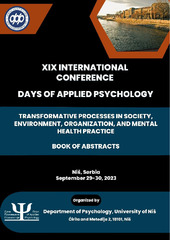| dc.contributor | Pedović, Ivana | |
| dc.contributor | Stojadinović, Miloš | |
| dc.creator | Bogićević, Dragana | |
| dc.creator | Bukvić, Lidija | |
| dc.creator | Popović-Ćitić, Branislava | |
| dc.creator | Trajković, Marija | |
| dc.date.accessioned | 2023-10-05T13:21:36Z | |
| dc.date.available | 2023-10-05T13:21:36Z | |
| dc.date.issued | 2023 | |
| dc.identifier.isbn | 978-86-7379-629-1 | |
| dc.identifier.uri | http://ipir.ipisr.org.rs/handle/123456789/964 | |
| dc.description.abstract | Disciplinary practices refer to procedures teachers use in school to manage student
behavior and promote self-discipline. The aim of this study is to examine the use of positive,
punitive, and SEL disciplinary techniques and their effects on students’ prosocial behavior.
The research sample consisted of 766 students (61.1% female) aged 15 to 19 years (M = 16.36, SD
= 1.04). Teachers’ disciplinary techniques were assessed using the Delaware Positive, Punitive, and
SEL Techniques Scale (four-point Likert-type scale, α = .87). The scale consists of three subscales
measuring students’ perceptions of the use of positive behavior techniques (6 items, α = .88),
punitive/corrective techniques (6 items, α = .74), and social emotional learning techniques (6
items, α = .88). Data on prosocial behavior were collected using the prosocial subscale of the
Strengths and Difficulties Questionnaire (5 items, α = .84). The data show that secondary teachers
use all three groups of disciplinary techniques to about the same extent, although SEL and positive
disciplinary techniques are used to a slightly greater extent. Results indicate that teacher
techniques are statistically significantly correlated with student prosocial behavior (r(764) = .40, p =
<.001). The strongest positive correlation was found between SEL learning techniques and
prosocial behavior (r(764) = .48, p = < .001), then with positive behavior techniques (r(764) = .39, p = <
.001), while a very weak negative correlation was found between punitive techniques and
prosocial behavior (r(764) = -.11, p = < .01). This correlation remains even when respondents’ age
and gender are taken into account. The results of this study suggest that in the school context, it
may be useful to plan interventions that promote the use of SEL and positive disciplinary practices
which can be effective for prevention of behavioral problems among students. | sr |
| dc.language.iso | en | sr |
| dc.publisher | Niš : Faculty of Philosophy | sr |
| dc.rights | openAccess | sr |
| dc.source | International conference days of applied psychology | sr |
| dc.subject | disciplinary practices | sr |
| dc.subject | prosocial behavior | sr |
| dc.subject | high school students | sr |
| dc.subject | prevention practice | sr |
| dc.title | Teachers’ disciplinary practices and prosocial behavior in high school students | sr |
| dc.type | conferenceObject | sr |
| dc.rights.license | ARR | sr |
| dc.citation.epage | 69 | |
| dc.citation.spage | 69 | |
| dc.citation.volume | 19 | |
| dc.description.other | Book of abstract:19th International Conference DAYS OF APPLIED PSYCHOLOGY 2023; Transformative Processes in Society, Environment, Organization, and Mental Health Practice | sr |
| dc.identifier.fulltext | http://ipir.ipisr.org.rs/bitstream/id/3020/dpp_book_of_abstracts_2023_1-9,69,96,97.pdf | |
| dc.identifier.rcub | https://hdl.handle.net/21.15107/rcub_ipir_964 | |
| dc.type.version | publishedVersion | sr |

